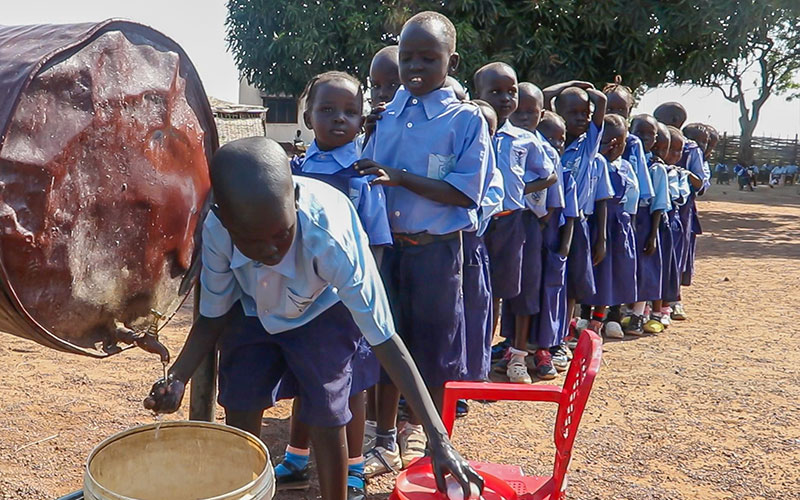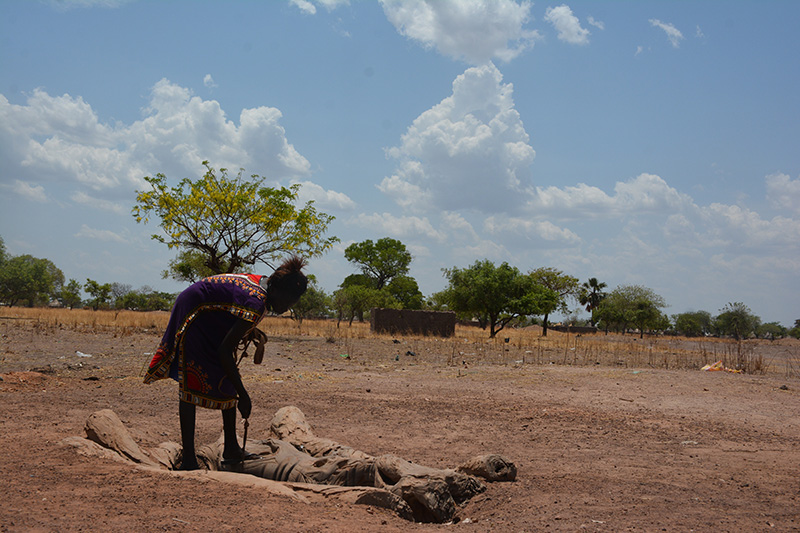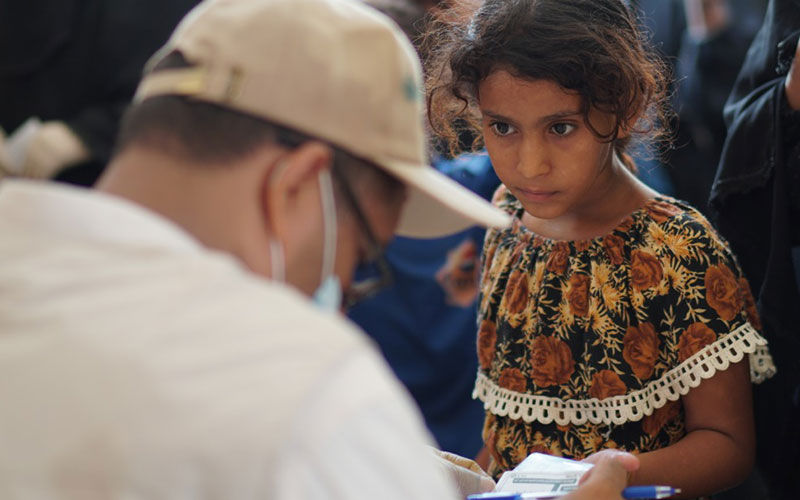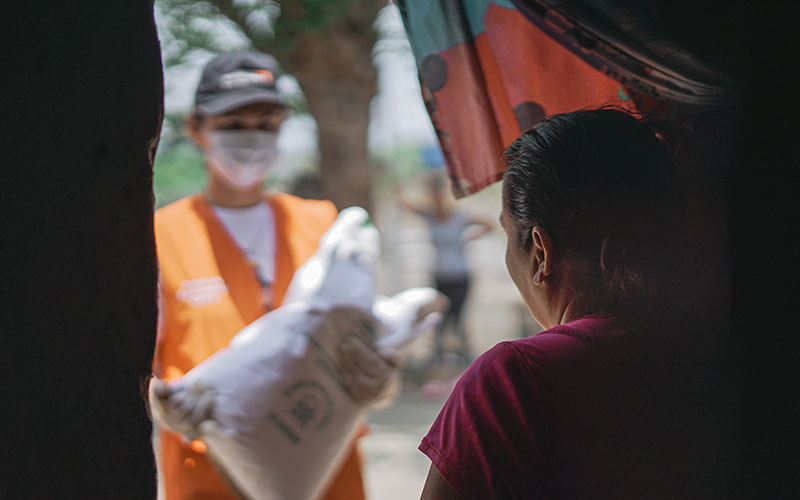Food crisis occurs when rates of hunger and malnutrition rise sharply at local, national, or global levels. And it’s happening at alarming rates. By April 2022,
global food prices were the highest they’d ever been. More than
276 million of the planet’s people across 53 countries/territories were staring down severe food insecurity. That’s
double the pre-pandemic levels.
But COVID has not been the only culprit. The crisis in Ukraine – chief exporter of grain for
hundreds of millions of people worldwide – has left many nations reeling. By May 2022, Ukrainian farmers had
20 million tons of grain they could not get into international markets.
Russia – also a key grain producer – halted its own exportation to non-Soviet countries. Nations like
Turkey, China, Egypt and India, accustomed to receiving agri-food products from Russia and Ukraine,
braced for their own food crises.
But even before 2022, global levels of hunger had surpassed all records previously reported by the Global Report on Food Crises. Regions at greatest risk were those already
facing multiple threats, like climate change, violent conflict and political and economic turmoil. Some examples: the Democratic Republic of Congo, Afghanistan, Ethiopia, Yemen, Nigeria, Syria, and South Sudan. (In many high-hunger countries, armed conflict is the primary driver of food crisis.)
This article explains why Canadians should pay attention to food crisis everywhere. You’ll learn where food crisis is happening, what causes it and how a country’s circumstances hasten it along. We’ll explore the impact of food crisis on children. And we’ll investigate the likelihood of a food crisis in Canada.
Support our global hunger response
GIVE NOW
Understanding ‘food crisis’
‘Food crisis’ is a situation in which food circumstances drastically worsen within a short period. It gripped at least
155 million people in 2020, with
most in just 10 countries. Violent conflict was the key driver, with extreme weather events and economic shocks also playing a role. In 2020, two out of three people facing acute food insecurity lived in Africa.
‘Food crisis’ is not the same as ‘chronic hunger’ or ‘food instability’, though they’re often interlinked. What makes ‘food crisis’ unique is the
rapidity of the worsening situation. Across countries and regions, entire communities may be catapulted from struggling to starving in a matter of months.
By the time a food crisis is officially declared in a region, thousands of families have already lost their livelihoods and exhausted their savings. Malnutrition is on the rise.
There is no time left for the global community to consider creative ways to help people build resilience. The world must act quickly to prevent widespread destruction of livelihoods and death.
 These Syrian refugees in Iraq rely on the kindness of strangers for food … but it’s never enough to stop the howling in the children’s bellies. Nearly half of deaths in all young children globally can be attributed to malnutrition. Photo: Meg Sattler
These Syrian refugees in Iraq rely on the kindness of strangers for food … but it’s never enough to stop the howling in the children’s bellies. Nearly half of deaths in all young children globally can be attributed to malnutrition. Photo: Meg Sattler
What makes food crises happen so quickly within countries like the Democratic Republic of Congo, Yemen, Syria, Afghanistan and South Sudan? In Canada, food shortage would likely
trigger government plans and programs to provide relief for our people. Why doesn’t that happen everywhere?
Because in fragile regions, governments, societies, and economies are often in turmoil. People are already spending all they have on food – going without essentials like medicine and livestock upkeep. Food crisis fuels conflict, and vice versa. Even the best-laid national plans can too easily be destroyed by drought or gunfire.
South Sudan food crisis example
Over half of the country's population was at risk of severe, acute food insecurity.

Even before COVID-19, many children in South Sudan relied on school feeding programs for nutrition. Schools opened in the spring of 2021, after 14 months of lockdown, yet the country is still in a food crisis. Photo: Cecil Laguardia
Large areas of South Sudan fit the official definition of ‘food crisis’, according to the global system used to assess food shortage situations. A tragic, ‘perfect storm’ has meant:
- violent conflict has forced millions to live on the run, unable to plant grains and vegetables, raise livestock or run their livelihoods,
- severe drought has robbed families and communities of crops, income, and community food reserves,
- lost livelihoods due to COVID-19 have pushed entire families across entire regions to the breaking point of survival.
 A teen bride in South Sudan draws water from a make-shift ditch, to do her domestic work. Climate change has parched the landscape, prompting food crisis when crops and livestock die. Photo: Jemima Tumalu
A teen bride in South Sudan draws water from a make-shift ditch, to do her domestic work. Climate change has parched the landscape, prompting food crisis when crops and livestock die. Photo: Jemima Tumalu
Food insecurity classification: The speed of food crisis onset
When so many factors combine, food crisis can descend in a matter of just months. Particularly with sudden global developments such as the Ukraine situation. Here’s how a food crisis might look for communities, according to the
Integrated Food Security Phase Classification system:
Phase 1 – Stable
At this stage, families in a community can meet essential food needs, along with non-food needs like medicine and house repairs. They are relatively self-sufficient. (In the world’s most fragile regions, millions of communities haven’t enjoyed this kind of stability for generations).
Phase 2 – Stressed
At this stage, many families have the minimum in food staples. But they may not be able to afford essentials like medicine, shelter repairs, school fees or the upkeep of livestock. Some people are already selling their more disposable assets. (In countries like South Sudan, Afghanistan and Venezuela, millions of families were already in the ‘Stressed’ or even ‘Crisis’ phases when COVID-19 hit.)
Phase 3 – Crisis
At this stage, the UN declares a food crisis. In large areas of a country, families would be making decisions which affect their ability to feed their families. Acute malnutrition begins to increase. Families often sell essential livelihood assets like oxen or sewing machines. Some might consider
marriage for their daughters, even those barely into their teens. Members of a family may migrate, in search of food or work.
In 2022, the annual Global Report on Food Crisis highlighted the remarkably high number of people at the ‘Crisis’ stage – or worse. It was the highest such number in the report’s six-year history.
The
nations forecast to be in Crisis or worse in 2022 include: the Democratic Republic of Congo, Afghanistan, Nigeria, Yemen, Ethiopia, South Sudan, Somalia, Sudan, Pakistan, Haiti and Kenya.
Phase 4 – Emergency
At this stage, in most communities within a country, families’ access to food is so drastically compromised that
acute malnutrition soars. Deaths increase, from malnutrition-related illnesses. Often, food can be acquired only through drastic measures like selling property, entering prostitution or selling a daughter into marriage.
In 2022,
just seven countries accounted for two-thirds of all people facing this degree of food insecurity globally. The seven countries were: the Democratic Republic of Congo, Afghanistan, Syria, Nigeria, Ethiopia, Zimbabwe and Haiti. Within these nations, millions of people faced malnutrition, starvation and death.

In a food crisis, the dowry parents can receive for a daughter, can keep the family's other children alive. In Yemen, years of civil war have pushed millions into severe malnourishment. This increases the temptation to marry off a young daughter. Photo: Elise Nalbandian
Phase 5 – Catastrophe/Famine*
At this stage, families are out of options throughout most of the country. People have taken every measure they can to raise funds or secure food. But there is a total lack of food. Starvation, death, destitution, and extremely critical acute malnutrition levels are clearly evident.
In May 2022, the UN warned that millions of people in Somalia could face famine within months. They noted that 49 million people in 43 countries were just one step away from famine.
* For Famine classification, an entire area needs to have extreme critical levels of acute malnutrition and mortality. Read what a Famine is and the steps involved with declaring one.
Food crisis around the world
Of the food crises identified in 2021, 10 stood out in terms of the number of people affected. Here are the
countries/territories with the highest number of people in food crisis (Phase 3 in the classification system we introduced earlier) or worse:
- Democratic Republic of Congo – 27.2 million people
- Afghanistan – 22.8 million people
- Ethiopia – 16.8 million people
- Yemen – 16.2 million people
- Nigeria – 12.9 million people
- Syria – 12 million people
- Sudan – 9.8 million people
- South Sudan – 7.2 million people
- Pakistan – 4.7 million people
- Haiti – 4.4 million people
*The numbers listed above are reflective only of the percentage of the country’s population that could be analyzed in 2021.
It’s often hard to get a complete, timely picture of unfolding food crisis amidst disasters like drought or conflict. Data collection becomes low priority when people are struggling for survival. Many affected regions are remote, in countries with limited infrastructure. And food crisis develops so quickly, numbers can change drastically from one month to the next.
 COVID-19 just increases the risk of food crisis in fragile regions in Honduras. World Vision teams have been delivering aid to people’s homes, to prevent the worst from happening. Photo: Katherine Bustamante
COVID-19 just increases the risk of food crisis in fragile regions in Honduras. World Vision teams have been delivering aid to people’s homes, to prevent the worst from happening. Photo: Katherine Bustamante
Available data gives a chilling sense of what’s happening in some regions of a country. If a community is unreachable due to violent conflict, it’s highly unlikely that families can access even a basic food supply. The
Global Network Against Food Crises analyzes data in current and emerging food-shortage situations. According to their May 2022 update:
- 36 out of 55 countries with food crisis depended on Ukrainian and Russian exports for more than 10 per cent of their total wheat imports.these food crises were driven by persistent conflict, pre-existing and COVID-19-related economic shocks, and weather extremes,
- Globally, recent food crises have been driven by persistent conflict, pre-existing and COVID-19-related economic shocks, and weather extremes.
- The number of affected countries/territories identified in the 2021 was the highest in the report’s six-year existence.
- Forecasts pointed to a grim outlook for 2022.
How food crisis hurts children and women
Food crisis affects people of every age, but
children are often the most vulnerable of all. According to UNICEF,
more than half of the world’s children experiencing malnutrition and its lifelong impacts are living in countries affected by food crisis.
Nutrition-related factors contribute to about
45 per cent of deaths in children under five. For children who survive food crisis, the lack of nutrition they experienced during key childhood development windows can mean a
lifetime of struggle. In these countries,
one of every two children is stunted, physically, developmentally, or both.
 In many regions, women and girls are expected to eat last, least and of poorer quality food. This leaves them more vulnerable in a food crisis. Photo: Porimpe Isaac Sogoba
In many regions, women and girls are expected to eat last, least and of poorer quality food. This leaves them more vulnerable in a food crisis. Photo: Porimpe Isaac Sogoba
A few other ways food crisis can devastate children’s futures:
- Children can lose a parent or caregiver to malnutrition or illness, increasing poverty within the family. In this case, children are often called on to assume adult roles, dropping out of school to work or raise younger siblings.
- Children’s families can be forced to migrate in search of work or food, cutting off children from community support and protection.
- Children can be sent out to work, to help put food on the table. Often, they are drastically underpaid to do work that’s degrading or very dangerous. Having left school, it’s often impossible to catch up, affecting a child’s prospects for a lifetime.
- Girls can be forced into early marriage for a dowry, to help feed her other family members. COVID-19 has exacerbated this tragic situation. Child brides can face a lifetime of abuse and poverty, as well as the threat of death from early childbirth.
 In Yemen, women and children line up to collect emergency assistance. Despite ongoing humanitarian assistance, more than 16 million people there are food insecure. Photo: Elise Nalbandian
Women and girls in food crisis
In Yemen, women and children line up to collect emergency assistance. Despite ongoing humanitarian assistance, more than 16 million people there are food insecure. Photo: Elise Nalbandian
Women and girls in food crisis
Women and girls are more likely to be hurt by food shortage as
they experience hunger and malnutrition disproportionately. In many regions a woman or girl is often expected to eat last, least and poorer-quality food – and that’s when food is available. Imagine how this plays out when food is scant.
Fighting back against food crisis
Canada is working to eradicate food insecurity crises through its own programs and policies, and in partnership with other nations. Our country joins with groups like World Vision to improve food security, reducing the likelihood of food crisis wherever and whenever possible. When it does occur, countries and organizations link arms, acting swiftly and decisively to help save lives.
Our World Food Programme partnership
World Vision works closely with the
World Food Programme (WFP) to bring emergency food to communities facing food crisis. We distribute more food for the WFP than any other organization, often in remote or dangerous regions. In 2021 alone,
World Vision reached close to 12 million people in 31 countries with food from the WFP. Of those recipients, nearly 60 per cent were children.
 Each year, World Vision works with the World Food Programme to provide food and cash assistance to millions of the world’s most vulnerable families. Photo: Mohammad Elias Hatimi
Global partnerships to prevent food crisis
Each year, World Vision works with the World Food Programme to provide food and cash assistance to millions of the world’s most vulnerable families. Photo: Mohammad Elias Hatimi
Global partnerships to prevent food crisis
All United Nations member states – including Canada – have
committed to transforming food systems to transform our world. Ensuring this happens is a worthy end unto itself. But few of
the goals in the global 2030 Agenda for Sustainable Development can be met without also:
- ending hunger and malnutrition,
- having sustainable and resilient, climate-compatible agriculture and food systems,
- creating food systems that are good for both people and the planet.
Goals like “No Poverty”, “Good Health and Wellbeing” and “Gender Equality” are intertwined with universal food security. Not only does access to nutritious food help empower women, for instance, their empowerment can help improve food security for an entire community.
 In South Sudan, Akech is a mother and leader of the Hadic Farmers Group. She has inspired more women to join farming, learning new techniques for better, more climate-friendly yield. This gives women greater earning power and a greater say in how income is used in the household. Photo: Cecil Laguardia
Canada’s response to food crisis
In South Sudan, Akech is a mother and leader of the Hadic Farmers Group. She has inspired more women to join farming, learning new techniques for better, more climate-friendly yield. This gives women greater earning power and a greater say in how income is used in the household. Photo: Cecil Laguardia
Canada’s response to food crisis
Global Affairs Canada partners with organizations like World Vision to fund programs for nutrition, food security and emergency food responses in countries around the world.
In addition, our country advocates on the global stage. In 2021, Canada attended the UN Food Systems Summit, ready to help identify solutions to the current global food crisis.
“COVID-19 has laid bare the risks and vulnerabilities in our food system,” said Karina Gould, who was then minister of international development. “But it is also an opportunity to do things better. We need to find and amplify new ways to increase food productivity, reduce waste, raise incomes equitably and improve health and nutrition.
“It is also time to re-examine how to ensure that our food system stays sustainable and supports biodiversity … Canada looks forward to contributing to this summit and to building more-resilient food systems both at home and abroad.”
How Canadians are helping combat food insecurity
Canadian organizations like Food for Famine
donate gifts in kind to groups like World Vision, helping children who are severely malnourished make a full recovery. Individual Canadians help by:
- donating during emergency appeals,
- sponsoring children overseas to strengthen food security in their communities,
- supporting our Raw Hope initiative, to strengthen children in the world’s toughest places,
- by giving a nutrition gift in honour of a friend or family member, through our Gift Catalogue.
 In Kenya, the gift of goats can provide families with nutritious milk and cheese to enjoy and sell for income. Proceeds can help pay for medicine, home repairs and school fees. Photo: Zipporah Kageha Karani
In Kenya, the gift of goats can provide families with nutritious milk and cheese to enjoy and sell for income. Proceeds can help pay for medicine, home repairs and school fees. Photo: Zipporah Kageha Karani
Should Canada fear a food crisis?
It’s imperative that we Canadians pay attention to food crisis in the news. And not just because we care about the millions of families suffering there.
Not even wealthy countries are immune to the possibility of food crisis in the future. A worldwide food crisis is possible if certain trends (e.g., climate change and population growth) continue and key global goals remain unmet.
But today, Canada is a long way from experiencing ‘food crisis’ according to the official definition. We have strong social programs and trade networks, as well as an infrastructure that allows us to move food around the country. Our population doesn’t face the same violent conflict, economic chaos and climate change impact as millions of the world’s people.
That said, affordable and nutritious food is often an ongoing struggle for some families in Canada. The COVID-19 pandemic has only made things worse. For example:
In December 2020, Canada’s government announced an
additional $100 million in funding to food banks and food security organizations, to help Canadians through food shortages related to the COVID-19 pandemic. They announced further top-ups, in August 2021 and December 2021, of $100 million each.